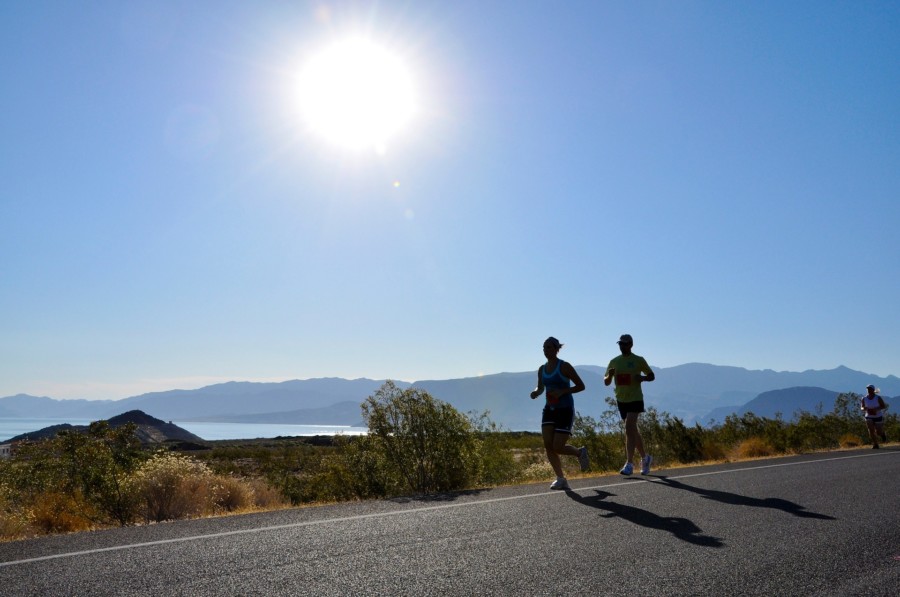Tips for Exercising in Hot Weather

WORKING OUT IN THE HEAT?
It’s only early June and here in Northern California, we’ve already seen a few triple digit days. It not only sends our utility bills soaring by running those air conditioners, it affects our daily fitness routine — and it should. What you can do on a par course or your favorite running trail in 70 degrees is not what you can – or should – do in 102 degrees.
In this article we share warning signs, tips and advice for heat exhaustion, heat stroke, and how to prevent heat related illnesses. We were particularly interested to learn the tip about fans only being effective on moist skin. Fortunately, we love keep green tea tonic on hand and a quick spritz to the face in front of our desk fans does the trick on a hot afternoon.
PREVENTING HEAT RELATED ILLNESSES
- Be aware of the warning signs of heat-related illness, such as light-headedness, mild nausea or confusion, sleepiness or profuse sweating.
- While outdoors, rest frequently in a shady area so that your body’s thermostat has a chance to recover.
- Schedule outdoor activities carefully, preferably before noon or in the evening,
- If unaccustomed to working or exercising in a hot environment, start slowly, pick up the pace gradually and limit your exercise or work time.
- Wear sunscreen to protect skin from the sun’s harmful rays. Sunburn affects your body’s ability to cool itself and causes a loss of body fluids.
- Wear lightweight, light-colored, loose-fitting clothing.
- When working in the heat, monitor the condition of your co-workers and have someone do the same for you. If you are 65 years of age or older, have a friend or relative call to check on you twice a day when hot weather health advisories have been issued.
- Stay indoors and in an air-conditioned environment. If air conditioning is not available, consider a visit to a shopping mall, public library, movie theater, supermarket or other air-conditioned location for a few hours.
- Increase your fluid intake—regardless of your activity level. Don’t wait until you feel thirsty to drink fluids. Ensure infants and children drink adequate amounts of liquids.
- Avoid drinks containing caffeine, alcohol, or large amounts of sugar because they will actually cause you to lose more fluid. Also, avoid very cold beverages because they can cause stomach cramps.
- Electric fans may be useful to increase comfort and to draw cool air into your home at night, but do not rely on a fan as your primary cooling device during a heat wave. When the temperature is in the upper 90s or higher, a fan will not prevent heat-related illness. A cool shower or bath is a more effective way to cool off. (See paragraphs below.
- Check regularly on those at greatest risk of heat-related illness — infants and children up to 4 years of age, people 65 years of age or older, people who are overweight, people who overexert during work or exercise, people who are ill or on certain medications.
- Avoid hot foods and heavy meals.
- Ask your doctor whether medications you take affect your body’s response to the heat.
- Do not leave infants, children or pets unattended in a parked car or other hot environment.
USING FANS FOR COOLING
In order for a fan to be effective, the skin surface must be moist. When the skin surface is moist, moving air removes heat from the skin as the moisture evaporates. Unfortunately, when a person begins to develop heat stroke, they stop sweating. In addition, elderly persons may not sweat due to poor heat regulation messages sent out by their brain centers. If a fan is to be effective, the skin must be moist either with sweat, or with dampened clothing, or with moisture added by rubbing wet cloths over the skin surface.
Although fans are less expensive to operate, they may not be effective as indicated above, and may even be harmful, when temperatures are very high. As the air temperature rises, air flow is increasingly ineffective in cooling the body until finally, at temperatures above about 100° F (the exact number varies with the humidity) increasing air movement actually increases heat stress. More specifically, when the temperature of the air rises to about 100° F, the fan may be delivering overheated air to the skin at a rate that exceeds the capacity of the body to get rid of this heat, even with sweating, and the net effect is to add heat rather than to cool the body. The widespread distribution of fans, often practiced in the past as a heat-relief measure, thus appears unlikely to be particularly effective in preventing major heat-related health effects when temperatures are very high. The better alternative by far when the temperature soars is to use an air conditioner if one is available or to seek shelter in an air-conditioned building.
HEAT EXHAUSTION
Heat exhaustion is the body’s response to an excessive loss of the water and salt contained in sweat. Those most prone to heat exhaustion are elderly people, people with high blood pressure and people working or exercising in a hot environment.
WARNING SIGNS
- Heavy sweating
- Paleness
- Muscle cramps
- Tiredness and weakness
- Dizziness or fainting
- Headache
- Nausea or vomiting
WHAT TO DO
- Rest in a cool, preferably air-conditioned area
- Loosen clothing
- Cool down with a shower, bath or sponge bath
- Drink plenty of non-alcoholic and caffeine-free beverages
- Seek medical attention if symptoms worsen or last longer than one hour
HEAT STROKE (LIFE THREATENING)
Heat stroke occurs when the body becomes unable to control its temperature: the body’s temperature rises rapidly, the sweating mechanism fails, and the body is unable to cool down. Heat stroke can develop within minutes or hours. Heat stroke can cause death or permanent disability if emergency treatment is not given. Treatment includes rapidly lowering the person’s body temperature followed by intensive supportive care.
WARNING SIGNS
- Extremely hot body temperature (above 103* F orally)
- Red, hot and dry skin (no sweating)
- Rapid pulse
- Throbbing headache or dizziness
- Nausea
- Confusion
- Unconsciousness
WHAT TO DO
- Call for IMMEDIATE MEDICAL ASSISTANCE
- Move the victim to a cool or shady area
- Cool the victim rapidly (put in a tub, shower, spray with cool water from hose)
- Monitor body temperature and continue cooling until the body temperature drops to 101-102* F
Resources
- https://health.mo.gov/news/newsitem/uuid/10e5612a-1031-42ef-a089-6d926a7cf141

